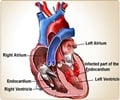40-year-old Michael LeBlanc is the first in North Texas to receive the newest generation of a mechanical device designed to improve heart function
40-year-old Michael LeBlanc is the first in North Texas to receive the newest generation of a mechanical device designed to improve heart function. It will be his lifeline while he awaits a heart transplant.
Called a left-ventricular assist device (LVAD), its purpose is to help a patient's weakened heart pump blood throughout the body. For Mr. LeBlanc, it will help his ailing heart continue to pump until the Irving resident receives a new heart. UT Southwestern is the only medical facility in North Texas implanting the HeartWare Ventricular Assist System as part of a national clinical trial testing the effectiveness of the device.The HeartWare Ventricular Assist System is a little smaller than a hockey puck and two and half times smaller than the earliest versions of LVADs.
Mr. LeBlanc, a Chicago native, moved to the Dallas area 11 years ago in search of new job opportunities. The normal trajectory of his daily life veered wildly when a simple episode of fainting resulted in a life-changing diagnosis: heart failure.
"I kept getting weaker and weaker," he said. "I was blacking out for no reason. I hadn't been sick and have never been a sickly person."
Occasionally, viruses can attack the heart and leave it severely damaged, but people may not know until months or years later. Mr. LeBlanc's doctors theorized he may have had such a virus that ultimately led to heart failure.
"My energy level was up and down. To keep me going, I qualified for a defibrillator, which basically shocked me if my heart rhythm started to get worse," Mr. LeBlanc said. "But as I got sicker, the defibrillator kept going off, and it was awful."
Advertisement
"Mr. LeBlanc has cardiomyopathy, which causes the heart to dilate. The muscle becomes weaker, and it can't pump efficiently," said Dr. Dan Meyer, professor of cardiovascular and thoracic surgery at UT Southwestern and Mr. LeBlanc's surgeon. "UT Southwestern has always had a presence in studying new mechanical assist devices, so we were honored to be only one of two sites in the state selected to implant the HeartWare LVAD as part of a national clinical trial."
Advertisement
"The size of the device means the incision is also smaller. The entire implantation surgery takes about four hours," Dr. Meyer said. "Mr. LeBlanc is a really great patient. He's otherwise very healthy, and we believe he will do very well with the LVAD until he can get a new heart."
Only a few days after his surgery to implant the device, Mr. LeBlanc said he was feeling much better and he hopes for a quick return to his daily routine. He's still adjusting to some of the stranger side effects of his new device, including no pulse. The LVAD keeps blood moving continually with no pulsation, so he no longer has a palpable heart beat or traditionally measurable blood pressure.
"I'm very happy to have this LVAD, and I think I'll adjust to it fast. I'm just ready to get on with my life," Mr. LeBlanc said. "I've been through everything, and I hope this is the last step I need to take before transplant surgery."
Source-Eurekalert
RAS














